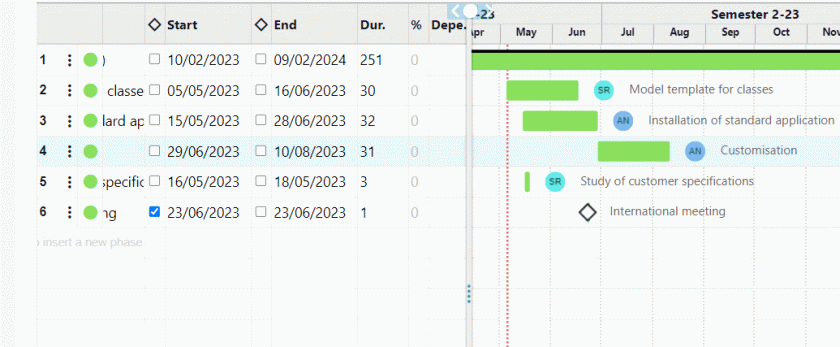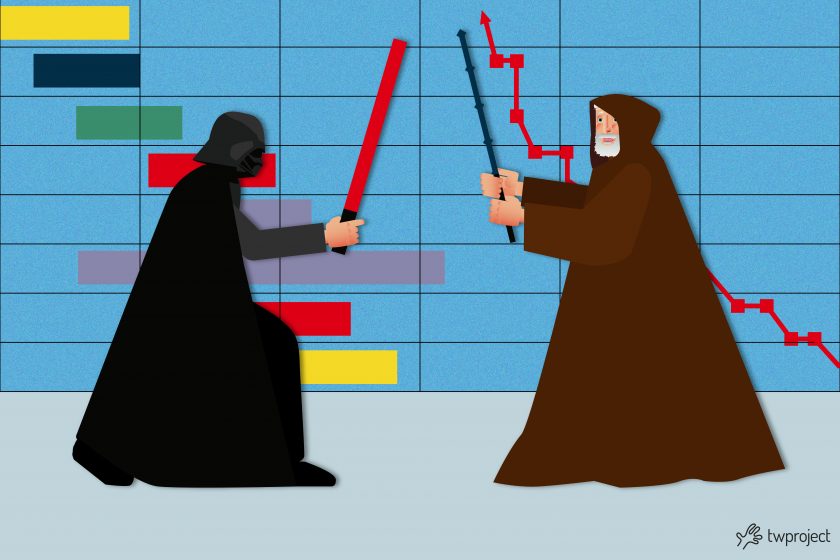Gantt vs Agile? Choosing between tools and methodologies in project management can significantly impact your project’s outcome.
Understanding the peculiarities of a planning tool such as Gantt and a dynamic methodology such as Agile is critical for project managers who strive to optimize processes and lead their work teams to success.
We will examine their differences, benefits, and potential combinations for effective project management.
CONTENT
- Gantt vs Agile: key differences
- Gantt vs Agile: pros and cons
- Pros of the Gantt chart
- Pros of the Agile methodology
- Is it possible to combine Gantt and Agile?
- 1.Strategic planning and operational flexibility
- 2.Progress monitoring and quick iterations
- 3.Better communication and customer involvement
- 4.Resource optimization and efficiency
- 5. Response to change and innovation
- Twproject: the ultimate solution for Gantt and Agile
Gantt vs Agile: key differences
The distinction between the Gantt chart and Agile is fundamentally rooted in their nature – the Gantt chart is a visual tool for planning and monitoring project phases, visualizing the length and sequence of activities on a time axis.
Conversely, Agile provides a flexible and iterative methodology designed to adapt to quick changes and promote continuous feedback between development teams and customers.
This core difference strongly impacts how project managers approach the structuring, execution, and adaptation of their projects.
The choice between Gantt and Agile and the decision to integrate them depends on the nature of the given project, the work environment, customer requirements, and team culture. Understanding these key differences is pivotal for project managers who seek to implement the most effective strategy for managing their projects.
Let’s take a look at their key differences:
1. Approach to planning:
- Gantt chart: It is based on detailed and sequential project planning. Activities are presented as colored bars on a chart, with clearly defined start and end dates. This approach provides a clear picture of the project and makes it easier to monitor progress; however, it can be inflexible and unsuitable for projects with variable requirements or in uncertain contexts.
- Agile: It is based on an iterative and incremental approach. The project is broken down into short cycles (sprints) lasting 1-4 weeks; a working version of the product is released at the end. This approach promotes flexibility and adaptability to change, making it ideal for projects involving uncertain settings or requirements that may evolve over time.
2. Team involvement:
- Gantt chart: The team’s involvement in the planning phase may be limited. The Gantt chart is often created by the project manager or a planning team, and the development team may only play a minor role in defining activities and timelines.
- Agile: The Agile methodology focuses on team involvement and collaboration. The development team is actively involved in sprint planning, task estimation, and decision-making. This approach supports the empowerment and motivation of the team.
3. Change management:
- Gantt chart: The Gantt chart is a strict tool that is not well-suited for frequent changes. Changing a single activity can have a chain effect on the whole project, requiring an update of the diagram and timetable.
- Agile: Agile methodology is designed to manage change flexibly. The sprint structure allows the project schedule to be revised and adapted frequently, incorporating feedback received and any changes in requirements.
Gantt vs Agile: pros and cons
Gantt and Agile offer distinct approaches to project planning, execution, and control, and each has its unique strengths.
Exploring both advantages can help project managers choose the best approach for their unique project needs, balancing detailed planning with the ability to adapt quickly to evolving challenges.
Pros of the Gantt chart:
- Detailed and accurate planning: Gantt provides a visual portrayal of the project plan, illustrating the duration, start, and end of each activity on a time axis. This way, project managers can plan in detail and easily understand the dependencies between different activities, ensuring that all teams are aware of the different activities.
- Progress monitoring: Project managers can easily monitor progress compared to the original plan, quickly spotting any delays or deviations from the schedule.
- Deadline orientation: The Gantt diagram is especially useful in projects with well-defined objectives and deadlines, where the sequence and duration of activities are clear from the get-go.

Pros of the Agile methodology:
- Short iterations and constant feedback: Agile is based on short development cycles, known as sprints, which make it possible to adapt quickly to changes and to incorporate feedback from customers or end users constantly.
- Better risk management: It helps to recognize and mitigate potential problems in advance.
- Collaboration and communication: The agile methodology emphasizes collaboration among team members and with customers, promoting open and frequent communication.
- Adaptability to change: Unlike Gantt, Agile allows for changes even at the late stages of a project, making it ideal for projects in dynamic and rapidly changing environments where requirements may change over time.
Is it possible to combine Gantt and Agile?
Integrating Gantt and Agile in a hybrid approach to project management offers many benefits to project managers, allowing them to leverage both qualities to drive teams to success in an increasingly complex and dynamic working environment.
1. Strategic planning and operational flexibility
The combination of Gantt and Agile allows managers to set a thorough strategic plan, thanks to the Gantt chart’s visibility on project phases and milestones.
Likewise, implementing Agile principles ensures the operational flexibility needed to adapt to changes, enabling the team to respond proactively to project and market needs. This balance between planning and adaptability is critical in complex projects where conditions can change rapidly.
2. Progress monitoring and quick iterations
The hybrid approach makes it easy to monitor project progress effectively, combining the straightforwardness of Gantt’s linear progress with Agile’s ability to implement changes quickly through fast iterations.
Project managers can, therefore, assess project progress concerning the original plan while preserving the flexibility to make corrections or adjustments based on feedback received during sprints.
3. Better communication and customer involvement
By integrating Gantt and Agile, project managers promote better communication within their teams and with customers.
Whereas Gantt provides a clear and understandable roadmap for all stakeholders, Agile supports continuous customer involvement, ensuring the final product is as close to expectations as possible.
This hybrid approach ensures that decisions are made with a full understanding of the project context, improving customer satisfaction and team effectiveness.
4. Resource optimization and efficiency
The combination of Gantt and Agile helps project managers optimize resource use, assigning tasks and priorities more effectively.
Thanks to Gantt’s in-depth planning and Agile’s flexibility, workloads can be balanced, resources can be allocated according to the evolving needs of the project, and waste can be reduced, increasing the team’s overall efficiency.
5. Response to change and innovation
Ultimately, the hybrid approach helps project managers to respond more effectively to change by using the Gantt structure to keep the project on track and the Agile methodology to integrate new ideas and innovations.
This improves the project’s ability to adapt to emerging challenges and promotes a working environment focused on innovation and continuous improvement.
Twproject: the ultimate solution for Gantt and Agile
Twproject stands out in the project management industry thanks to its superior solution that effectively integrates Gantt and Agile.
This tool is designed to simplify project management, making activity planning and monitoring more user-friendly, extremely flexible, and adaptable to different work contexts.
Twproject’s Gantt Chart is known as one of the best on the market for several reasons.
First and foremost, its user-friendliness does not come at the expense of power and versatility. Customers choose Twproject for its clear graphs, ease of monitoring project progress, and advanced features, such as visualization of task dependencies and real-time resource management.
The platform offers a wide range of dynamic features, including:
- Real-time resource allocation: Twproject provides an easy way to monitor and modify resource allocations, quickly identifying any over or under-allocations.
- Management of flexible working hours: It offers the option of setting customized work schedules for each team member, ensuring accurate work capacity planning.
- Project status supervision: Through dedicated dashboards, Twproject provides a real-time view of project progress, making it easier to detect any critical issues.
- Sharing and communication: The platform emphasizes the importance of communication in project management, providing tools for easy sharing of ideas, documents, and feedback.
- Task planning and management: This software blends planning management with Gantt and task entry for the whole team, bringing projects closer to the day-to-day work of the resources.
Twproject‘s adaptability to different working methods, its user-friendly interface, and powerful features make it a must-have tool for project managers who want to optimize their project management, improving team communication and overall efficiency.



